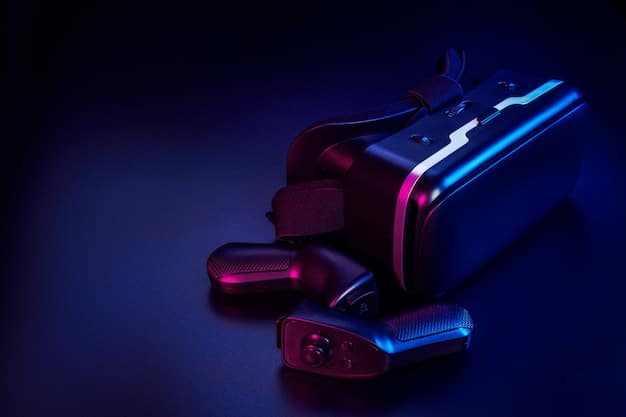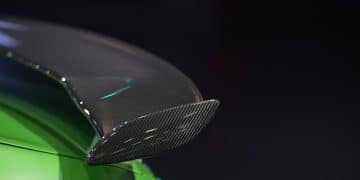Xbox Series X Refresh in 2025: Will it Boost Frame Rates by 15%?

The potential Xbox Series X refresh in 2025 is rumored to bring performance enhancements, with speculation centering on a 15% frame rate boost; however, official confirmation and detailed specifications are still pending, necessitating a cautious approach to these early reports.
The gaming world is abuzz with speculation: will the new Xbox Series X refresh boost frame rates by 15% in 2025? As whispers turn into louder conversations, players and industry analysts alike are questioning the validity and implications of such a significant upgrade. This potential refresh isn’t just about minor tweaks; it signals a possible shift in console gaming performance, promising a smoother, more immersive experience. But how realistic is this 15% jump, and what could it mean for the future of Xbox?
the landscape of console refreshes and the xbox precedent
Console refreshes are not a new phenomenon in the gaming industry. Historically, manufacturers have released mid-generation updates to their hardware, often featuring minor improvements in design, efficiency, or storage. Think of the PlayStation 4 Pro or the Xbox One X – these consoles offered enhanced performance over their base counterparts, catering to gamers who desired a more premium experience or had 4K displays. These refreshes help extend the life cycle of a console generation, bridge technological gaps, and keep the market engaged between major generational leaps.
Xbox, specifically, has a strong history of iterating on its hardware. The original Xbox One saw several iterations, culminating in the powerful Xbox One X. This trend suggests that a refresh for the Xbox Series X is not only plausible but almost expected given the typical console life cycle. The question isn’t so much if a refresh will happen, but rather what form it will take and what performance gains it will genuinely deliver. A 15% frame rate boost, as rumored, would be a substantial improvement, potentially influencing game development and player expectations.
understanding the “pro” console trend
The “pro” model strategy has proven successful, offering a more robust option without fully alienating owners of the original console. These often include:
- 📈 Enhanced GPU performance for higher resolutions or frame rates.
- 💾 Increased storage capacity, sometimes with faster read/write speeds.
- ⚡ Improved cooling systems for sustained performance.
These upgrades are usually subtle enough not to fragment the player base entirely, ensuring that new games still run on the base model, albeit with compromises. Yet, a significant frame rate boost could push that boundary, making the “pro” model a much more attractive proposition for competitive players or those seeking the best visual fidelity.
The previous Xbox One X, for example, aimed at delivering true 4K gaming, setting a new standard for console graphical fidelity at the time. A potential Xbox Series X refresh would likely build upon this legacy, aiming to perfect resolution and frame rate targets that are sometimes elusive on the current hardware, especially in demanding modern titles. Gamers always crave performance, and a refresh is the most direct way to satisfy that craving mid-cycle.
the technical feasibility: a 15% jump in frame rates
Achieving a 15% frame rate boost through a mid-generation refresh is a significant claim, one that requires a closer look at the underlying technology. Modern consoles, including the Xbox Series X, are already powerful machines, pushing the boundaries of what’s possible within a set thermal and power envelope. A performance increase of this magnitude typically comes from a combination of factors, not just a single component upgrade.
One primary area for improvement would be the Graphics Processing Unit (GPU). A die shrink, which means manufacturing the chip on a smaller process node (e.g., moving from 7nm to 5nm or even 4nm), could theoretically allow for more transistors in the same area, or the same number of transistors operating more efficiently at higher clock speeds. This efficiency gain alone can lead to noticeable performance improvements and better power consumption.
Additionally, optimizing the console’s architecture or integrating new, more efficient memory solutions could contribute to frame rate increases. While an entirely new CPU is unlikely in a mid-cycle refresh due to compatibility concerns, minor tweaks to clock speeds or cache sizes could offer incremental gains. The challenge lies in delivering these improvements without substantially increasing the manufacturing cost or the console’s physical footprint.
potential hardware upgrades for performance
Several components could be targeted in a refresh to achieve the rumored performance uplift:
- 🚀 **GPU Clock Speed Increase:** Even a modest boost in GPU clock speed can translate to better frame rates.
- 🔬 **Smaller Process Node:** A move to a more advanced manufacturing process (e.g., TSMC 4nm) would yield more efficient, powerful chips.
- 🧠 **Faster or More Efficient Memory:** While less likely to be a dramatic change, small improvements in memory bandwidth could help.
- 💡 **Optimized Cooling Solutions:** Better cooling allows components to run at higher speeds for longer periods without throttling.
These technical considerations are crucial. A 15% increase isn’t a small feat; it implies significant engineering efforts. It would mean that games targeting, for example, 60fps on the current Series X might reach closer to 70fps on the refreshed model, or games currently struggling at 30fps could achieve a much more stable 35-40fps. This distinction is meaningful for players, impacting the perceived smoothness and responsiveness of gameplay.

implications for gamers and game developers
The potential for a 15% frame rate boost in a refreshed Xbox Series X carries significant implications for both gamers and game developers. For players, the immediate benefit is obvious: smoother gameplay, more stable frame rates, and potentially higher resolutions in demanding titles. This could translate to a more enjoyable and immersive experience, particularly in fast-paced action games or graphically intensive open-world adventures. Competitive gamers, who often prioritize every single frame, would undoubtedly notice and appreciate such an upgrade.
However, it also raises questions about game optimization. Will developers be expected to target the refreshed console’s capabilities, potentially leaving the base Series X behind? Or will the refresh primarily serve to improve existing titles and offer a more consistent experience across the board? Ideally, a refresh aims to enhance, not fragment, the user base.
developer challenges and opportunities
For game developers, a console refresh presents a double-edged sword. On one hand, it offers new avenues for pushing graphical fidelity and performance:
- 🎮 **Higher Fidelity Targets:** Developers can aim for more ambitious visual settings and effects.
- 🔄 **Improved Performance Caps:** Games that currently have 30fps or 60fps caps might see a stable 40fps or 75fps option.
- 📈 **Easier Optimization:** The increased overhead can make it easier to hit performance targets without extreme optimization tricks.
On the other hand, it could add complexity. Developers might need to ensure their games scale effectively across both the base and refreshed models, adding to development time and cost. The pressure to harness the extra power could also lead to more demanding games that struggle on older hardware, potentially causing frustration for players who can’t upgrade.
Ultimately, a refresh could push the industry forward, encouraging developers to innovate with their game engines and design choices. The promise of higher frame rates often means better responsiveness, which can be critical for game genres like first-person shooters or fighting games, where split-second reactions are vital. The improved hardware could allow for more complex AI, richer environmental detail, and faster loading times, all contributing to a superior gaming experience even beyond raw frame rate numbers.
market reaction and competition: xbox vs. playstation
The console market is a fiercely competitive landscape, primarily dominated by Xbox and PlayStation. Any significant hardware refresh from one player inevitably impacts the strategy of the other. If Microsoft does release an Xbox Series X refresh with a 15% frame rate boost, it would put pressure on Sony to respond, either with a PlayStation 5 Pro (which has also been heavily rumored) or by showcasing other advantages in its ecosystem.
The timing of these refreshes is strategic. Releasing a more powerful console mid-generation can capture market share, entice new customers considering a console purchase, and encourage existing users to upgrade. It’s a way to generate excitement and maintain sales momentum in the middle of a console generation, preventing a lull before the next full generational leap.
the battle for performance and features
The rivalry often boils down to several key areas:
- 🚀 **Raw Performance:** Frame rates, resolution, and graphical fidelity.
- Exclusive Games: Unique titles that are only available on one platform.
- 🖥️ **Ecosystem and Services:** Features like Game Pass, PS Plus, cloud gaming, and user interface.
- 💲 **Price and Value:** How well the console’s performance and features justify its cost.
A performance boost for Xbox could swing the debate in Microsoft’s favor for gamers prioritizing raw power. However, PlayStation’s strong exclusive lineup and loyal fanbase mean that performance alone may not be the decisive factor. The ultimate success of any refresh will depend on a holistic package that includes not just hardware but also compelling software and services.
The goal is to create a compelling narrative for consumers. For Xbox, a performance-focused refresh could reinforce its image as the “most powerful console.” For players, it means having better choices, with manufacturers pushing the innovation envelope. This competition ultimately benefits consumers by driving technological advancements and improving the overall quality of gaming experiences.
the role of software optimization and game pass
While hardware upgrades are crucial for boosting frame rates, the role of software optimization cannot be overstated. Even the most powerful hardware can be underutilized if game engines and operating systems are not efficiently designed. Microsoft’s efforts in software optimization, including updates to the Xbox operating system and developer tools, can play a significant role in how well a refreshed Series X performs. The rumored 15% boost might not solely come from new silicon but also from software refinements that better leverage the existing or slightly upgraded hardware.
Furthermore, Xbox Game Pass plays a pivotal role in the Xbox ecosystem. A refreshed console, offering superior performance, could make Game Pass an even more attractive proposition. Imagine playing a vast library of games, many developed to take full advantage of the improved frame rates, all available through a subscription. This combination of powerful hardware and a compelling service could be a potent selling point for the refreshed console.
synergy between hardware and software
Microsoft’s strategy often involves a tight integration between its hardware and software:
- 💻 **Operating System Efficiency:** A streamlined OS means more resources for games.
- 🛠️ **Developer Tooling:** Providing better tools for developers to optimize games for the new hardware.
- ☁️ **Cloud Gaming Integration:** Leveraging the refreshed console for both local and cloud-streamed experiences.
The goal of these software efforts is to maximize the return on the hardware investment. A 15% frame rate boost could appear more significant if accompanied by software that ensures every bit of that extra power is utilized effectively in games. This holistic approach is what defines a true next-generation gaming experience, rather than just a simple hardware bump.
Game Pass, with its continuous influx of new titles, keeps players engaged and provides a direct benefit to owning an Xbox console. If the refreshed Series X can deliver a consistently smoother and more performant Game Pass experience across its diverse library, it further solidifies its value proposition. This combination creates a powerful ecosystem that encourages both new sign-ups and upgrades from existing users, driving overall platform adoption and engagement.
examining the source of the rumors and their credibility
In the fast-paced world of tech and gaming, rumors are a constant. The claim that an Xbox Series X refresh in 2025 will boost frame rates by 15% is no exception. Such information typically originates from various sources: anonymous tips from supply chain partners, leaks from internal documents, or speculative analysis by industry insiders. The credibility of these rumors largely depends on the source’s track record and the consistency of the information across multiple outlets.
Without official confirmation from Microsoft, all these claims remain speculative. However, when multiple reputable leakers or industry analysts suggest similar details, the probability of the rumor holding some truth increases. Gamers have learned to sift through the noise, recognizing that some whispers eventually materialize into official announcements, while others fade away without a trace.
how rumors shape expectations
Rumors, even unconfirmed ones, play a significant role in shaping public perception and consumer expectations:
- 🤔 **Consumer Anticipation:** Generates excitement and debate among the gaming community.
- 🛒 **Purchase Decisions:** Might influence potential buyers to wait for a refreshed model.
- ⚔️ **Competitive Pressure:** Forces rival companies to re-evaluate their strategies.
It’s vital for consumers to approach these rumors with a healthy dose of skepticism until official announcements are made. Over-reliance on unconfirmed reports can lead to disappointment if the final product doesn’t match the speculation. However, they also serve as a useful barometer of industry trends and potential future developments.
Microsoft has historically been tight-lipped about unannounced hardware, often preferring to surprise the market with official reveals. This strategy helps control the narrative and build anticipation. When discussing a 15% frame rate boost, it’s crucial to remember that official specifications, pricing, and release dates will be the definitive indicators of what to expect from any potential Xbox Series X refresh in 2025. Until then, these discussions fuel the excitement and debate within the passionate gaming community.
what to expect: realistic performance gains and future outlook
Given the history of console refreshes and the current technological landscape, what are realistic expectations for an Xbox Series X refresh in 2025, particularly concerning a 15% frame rate boost? While a 15% increase sounds substantial, it’s important to understand how such a gain would likely manifest in actual gameplay. It might not mean every game gets a flat 15% more frames per second. Instead, it could mean more stable frame rates in demanding scenarios, the ability to run games at higher quality presets, or opening up options for higher refresh rates on compatible displays.
A mid-generation refresh typically aims to tighten performance, smooth out inconsistencies, and possibly enable new visual features that weren’t fully achievable on the launch hardware. For instance, games that currently hover around 45-50 FPS in certain areas might more consistently hit 60 FPS on the refreshed model. Or, titles that demand a dynamic resolution scaling might be able to maintain a higher average resolution. This nuance is crucial for setting appropriate expectations and understanding the true value of such an upgrade.
key performance areas to watch
When considering an Xbox Series X refresh, several performance areas would likely see improvements:
- 🎮 **Ray Tracing Performance:** Smoother or higher quality ray tracing effects.
- 📈 **Consistent 60FPS or 120FPS:** Better stability in games targeting these frame rates.
- 🎨 **Dynamic Resolution Stability:** Fewer dips in resolution during intense gameplay.
- ⚡ **Faster Loading Times (Minor):** Incremental improvements, perhaps from optimized storage controllers.
The future outlook for Xbox remains strong, with a clear focus on Game Pass and the expansion of its core platform. A hardware refresh would reinforce this strategy by providing the best possible experience for that growing library of games. It would also position Xbox competitively against future hardware from rivals. While a 15% frame rate boast is a compelling rumor, the true impact will be in how these gains translate into tangible benefits for the player, enriching their overall gaming journey. The refresh is another step in the continuous evolution of console gaming, promising a more refined and powerful experience.

| Key Point | Brief Description |
|---|---|
| 🚀 Potential 15% Boost | Rumors suggest a significant frame rate increase for 2025 Xbox Series X refresh. |
| 🔬 Technical Feasibility | Likely achieved through GPU upgrades, smaller process nodes, and optimized cooling. |
| 🎮 Gamer Impact | Smoother gameplay, more stable frame rates, and potentially higher resolutions. |
| 💡 Market Competition | Pressures rivals like PlayStation to innovate; benefits consumers. |
frequently asked questions about the xbox series x refresh
No, an Xbox Series X refresh for 2025 has not been officially confirmed by Microsoft. All information regarding potential upgrades, including a 15% frame rate boost, currently comes from unofficial rumors and industry speculation. Gamers should await official announcements for definitive details.
A 15% frame rate boost would lead to noticeably smoother and more consistent gameplay. It could enable games to run closer to their target frame rates (e.g., 60fps instead of 50fps), improve stability in graphically demanding scenes, and potentially allow for higher quality visual settings without performance compromises.
Achieving a 15% frame rate increase typically involves a combination of factors. Key potential upgrades include moving to a smaller manufacturing process node for the GPU (e.g., 4nm), increasing GPU clock speeds, and implementing more efficient cooling solutions to sustain peak performance longer without thermal throttling.
Yes, existing Xbox Series X games are likely to benefit from a hardware refresh. While developers won’t re-optimize every old game, the improved hardware would simply run them more efficiently, leading to more stable frame rates, fewer performance dips, and possibly higher dynamic resolutions in titles that use such scaling.
Console refreshes often come with a premium price tag compared to the original launch models, especially if they offer significant performance gains. However, manufacturers also consider market competitiveness and manufacturing costs. The exact pricing would depend on the extent of the upgrades and Microsoft’s strategic positioning within the market.
conclusion
The rumor of an Xbox Series X refresh in 2025, potentially boosting frame rates by 15%, presents an exciting possibility for the gaming community. While currently unconfirmed, such an upgrade aligns with historical console life cycles and technological advancements. A performance increase of this magnitude would undoubtedly enhance the gaming experience, offering smoother visuals and more stable gameplay across a wide range of titles. For Microsoft, it would represent a strategic move to maintain competitiveness and reinforce the Xbox ecosystem, especially in conjunction with Game Pass. Gamers should remain cautiously optimistic, anticipating official announcements that will shed light on the future of Xbox hardware and the true extent of these compelling performance improvements.





